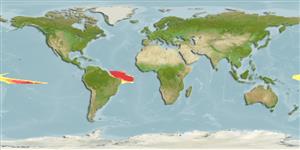Environment: milieu / climate zone / depth range / distribution range
экология
морской; пределы глубины 0 - 2000 m (Ref. 58302). Tropical; 15°N - 10°S
Southwest Atlantic, and western to eastern Central Pacific.
Size / Вес / Возраст
Maturity: Lm ? range ? - ? cm
Max length : 10.8 cm SL самец/пол неопределен; (Ref. 5123)
Краткое описание
определительные ключи | морфология | морфометрия
членистые (мягкие) лучи спинного плавника (общее число) : 9 - 10; членистые (мягкие) лучи анального плавника: 8 - 9; позвонки: 38 - 39. Branchiostegal rays 4. Head longer than N. atlantica, 27-30% SL. A dark pigment spot on the gular area that becomes obscure with growth in specimens larger than 9 cm SL (Ref. 5123).
Mesopelagic (Ref. 58302).
Life cycle and mating behavior
Maturities | размножение | Spawnings | Egg(s) | Fecundities | личинки
Kawaguchi, K. and J.L. Butler, 1984. Fishes of the genus Nansenia (Microsomatidae) with descriptions of seven new species. Los Angeles County Mus. Contr. Sci. 352:1-22. (Ref. 5123)
Статус Красного Списка МСОП (Ref. 130435)
Угроза для людей
Harmless
Использование человеком
дополнительная информация
инструменты
Специальные отчеты
Скачать в формате XML
ресурсы в Интернет
Estimates based on models
Preferred temperature (Ref.
123201): 5.9 - 11.1, mean 8.6 °C (based on 6 cells).
Phylogenetic diversity index (Ref.
82804): PD
50 = 0.5000 [Uniqueness, from 0.5 = low to 2.0 = high].
Bayesian length-weight: a=0.00389 (0.00180 - 0.00842), b=3.12 (2.94 - 3.30), in cm total length, based on all LWR estimates for this body shape (Ref.
93245).
Trophic level (Ref.
69278): 3.2 ±0.4 se; based on size and trophs of closest relatives
Fishing Vulnerability (Ref.
59153): Low vulnerability (10 of 100).
